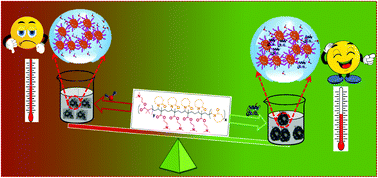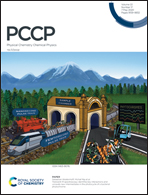Insulin-induced conformational transition of fluorescent copolymers: a perspective of self-assembly between protein and micellar solutions of smart copolymers†
Abstract
Synthesizing and understanding phase transition behavior of novel block copolymers is very crucial for fabricating next generation of smart materials with foreseeable applications. In this regard, we synthesized three random (r) copolymers of poly(N-vinyl-caprolactam) (PVCL) and poly(2-dimethyl amino ethyl methacrylate) (PDMAEMA) with varying percentages of each block and characterized them using nuclear magnetic resonance (NMR), Fourier transform infrared (FTIR) spectroscopy, X-ray diffraction (XRD) patterns, time-resolved fluorescence spectroscopy, and atomic force microscopy (AFM). Synthesized copolymers i.e. PVCL30–PDMAEMA70, PVCL50–PDMAEMA50 and PVCL70–PDMAEMA30 have fluorescence properties, which were confirmed by time-resolved fluorescence spectra and emission spectra, and emission bands were observed at ∼310, ∼435 and ∼424 nm, respectively. The fluorescence lifetime for PVCL50–PDMAEMA50 is larger than those of the other two copolymers suggesting a slow decay of the excited state. The copolymers have spherical geometry as micelles, which were confirmed by TEM. We observed patterned arrangement of micelles and the arranged micelles appear to be pentagon in shape, creating space in between the arranged micelles; however, for PVCL50–PDMAEMA50, the arranged micelles do not form any particular shape. The thermal phase transition of PVCL-r-PDMAEMA in aqueous solution was studied by differential scanning calorimetry and thermal fluorescence spectroscopy. In order to design a biomimetic polymer for bio-specific applications and to understand novel concepts towards polymer–protein interactions, we studied the effect of insulin on lower critical solution temperature (LCST) of PVCL-r-PDMAEMA using multiple sophisticated techniques. The LCST is finely tuned by incorporation of two blocks with various block compositions and the value falls within the range of human body temperature, making PVCL50–PDMAEMA50 a highly compatible material for bio-medical and bio-material applications. Insulin forms a self-assembly with the monomers of PVCL-r-PDMAEMA, which leads to enhancing the micellar aggregates and the eventual decrease in the LCST of the diblock copolymer aqueous solution. The present study provides new insights into insulin–copolymer interactions and can be used for self-assembling nanocarriers and designing protein resistance surfaces.

- This article is part of the themed collection: PCCP Emerging Investigators


 Please wait while we load your content...
Please wait while we load your content...